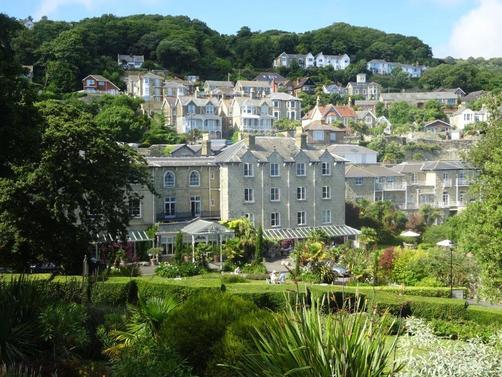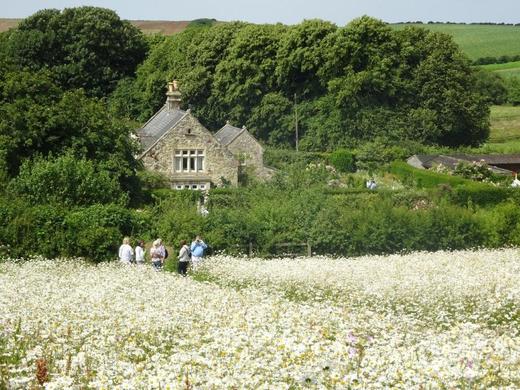Isle of Wight tour June 2017
Day One

The Royal Hotel
A three-day tour from a base at the Royal Hotel, Ventnor, visited gardens with a range of styles, some showing the influence of more Mediterranean themes to take advantage of the local climate and topography. Visitors enjoyed talks and tours from individual garden hosts who readily fielded members’ questions, sharing their own experiences and, sometimes, even offering their full planting lists to aid exploration.
The first morning began with a short tour of the gardens of the Royal Hotel, Ventnor, led by the head gardener, Gary Steptoe. Gary described a major replanting programme over the last 11 years. This has introduced varieties that make the most of soils ranging from sandy to clay above chalk, and conditions ranging from sheltered in front of the hotel to an exposed viewpoint across the road.
The next visit was to the Old Rectory near Kingston. In 14 years Louise and Derek Ness have created a series of rectangular garden rooms around the house plus delightful wildflower meadows in the fields above. The rooms include mixed herbaceous borders, a walled garden, a formal pond garden and a tea lawn, these contrasting well with the more informal wild areas and their swathes of ox-eye daisies in full bloom.

The Old Rectory from the top of the wild flower meadow
Northcourt gardens surround a 17th century Jacobean manor house and provided a delightful setting for a light lunch break during exploration of the grounds after an initial talk from the owner.

Northcourt

Northcourt
The house and grounds have only relatively recently come back into single ownership. The house now looks across a large lawn with rose and herbaceous borders to a lake and chalk stream which provide settings for moisture-loving plants. To the side of the house the walled kitchen garden is partly cultivated with some box hedges recently replaced as a result of disease. The sloping hillside behind the house contains new specimen trees amidst older planting.
n total contrast, the next garden visited, at 17th century Salterns Cottage in Seaview, is an attractive cottage garden close to the seafront on the edge of a site of historic salt pans and remains subject to occasional flooding.
The garden is reached through the house and has well kept herbaceous borders and immaculate vegetable beds. The owners, Susan and Noel Dobbs, served a welcome tea in the warm sunshine.
The return to Ventnor included a call at Eddington House Nursery. This has a new demonstration garden alongside a well stocked nursery which specialises in salvia, perennials and dry-garden plants. Horticultural retail therapy was enjoyed by many of our visitors.

The gardens of Salterns Cottage, Seaview

Departure from Eddington House Nursery with our purchases
A pre-dinner lecture on the ecology of the island was given at the Royal Hotel by Colin Pope, recently retired botanist and lecturer. Colin’s richly illustrated talk explained the island’s great variety of habitats resulting from its diverse geology and geography.
Day Two
The second day was spent at a number of locations along the Undercliff, the section of landslip terrain around Ventnor that gives sequences of low ridges and sheltered hollows, with a microclimate claimed to be several degrees warmer than elsewhere on the island and thus often suitable for Mediterranean-style planting.
In Bonchurch, Colin Pope led us round Rosemount, a garden with paths leading up a steep cliffside with planted terrace areas and ledges, leading to vantage points with features including real organ pipes amongst tree ferns.

Rosemount

The horizontal-stripe-shirted members line up for a photo at Rosemoun
Three houses along, on the same cul-de-sac off Bonchurch Shute, Judi and Sid Lines led visitors around Ashcliff, their garden created largely from scratch in a former quarry. The drive has richly coloured borders overlooked by a cliff with Echium in full bloom. Around the house, curvaceous and undulating areas of lawn lead on to a series of borders and plantings, including a shaded sunken area. The owners entertained visitors with drinks and refreshments on the house terrace.

Ashcliff, The Pitts
The next visit was to Ventnor Botanic Gardens. The original hospital on the site closed in 1964, subsequently being run as Steephill Pleasure Gardens and then, with Sir Harold Hillier’s involvement, developed as a botanical garden. This was managed by Isle of Wight Council until 2012 when it transferred to Ventnor Botanic Garden Community Interest Company. Gardens include South African, Australian, New Zealand, Mediterranean and arid sections. With no frost in the last four years, many exotic plants grow well outdoors with no special protection. Members were especially keen to see the rich flora in the Mediterranean and arid sections.

Part of the garden at Ashcliff
Ventnor Botanic Gardens

Ventnor Botanic Gardens
After lunch in the Edulis café, groups were led round the gardens by highly knowledgeable guides, Chris Kidd, the curator, and Sally Peake, head of the volunteers. Visitors were also intrigued to appreciate the current overall garden management philosophy behind how a trust with a limited budget maintains and enhances the collection. In contrast to a traditional botanic garden, the approach here is to allow associations of plants from a region, or of a type, to thrive, often seeding freely across its section. This results in flowing beds and borders with plants that thrive in the conditions here, such as echiums, spreading freely within their allotted areas.

Ventnor Botanic Gardens – arid section

Haddon Lake House
As rain began, the group moved a short distance to the last venue of the day, Haddon Lake House, where garden designer Phillippa and her husband Steve Lambert showed us round their garden at the foot of a steeply wooded slope.
The owners described their research into the 19th century development of the grounds, including a pleasure lake, through to the late 20th century use as a publicly open bird garden and subsequent restoration and rebuilding.
The current gardens include rich herbaceous beds with a cascade of colours down the hillside whilst the original walled garden has been redeveloped in a modern style with symmetrical features rich in well cared for fruit, vegetable and flower beds.
Day Three
Our last visit of the tour was a morning visit to Osborne House, an Italianate mansion built between 1845 and 1851 to provide Queen Victoria and Prince Albert with a private family home.
In steady rain, head gardener Toby Beasley, fresh from a recent television appearance marking the opening of the Lower Terraces after their £600,000 restoration, led members round the walled gardens and terraces.

Osborne House

Osborne House
Toby explained the history of the management of the walled gardens, from Prince Albert’s original designs through to English Heritage’s most recent plantings to best recreate the original approach. The tour also included the usually off-limits area of the potting sheds, themselves fascinating, original buildings maintained and operated in a traditional manner.
Some members continued with Toby to visit the terraces where the restoration was described.

Osborne House

